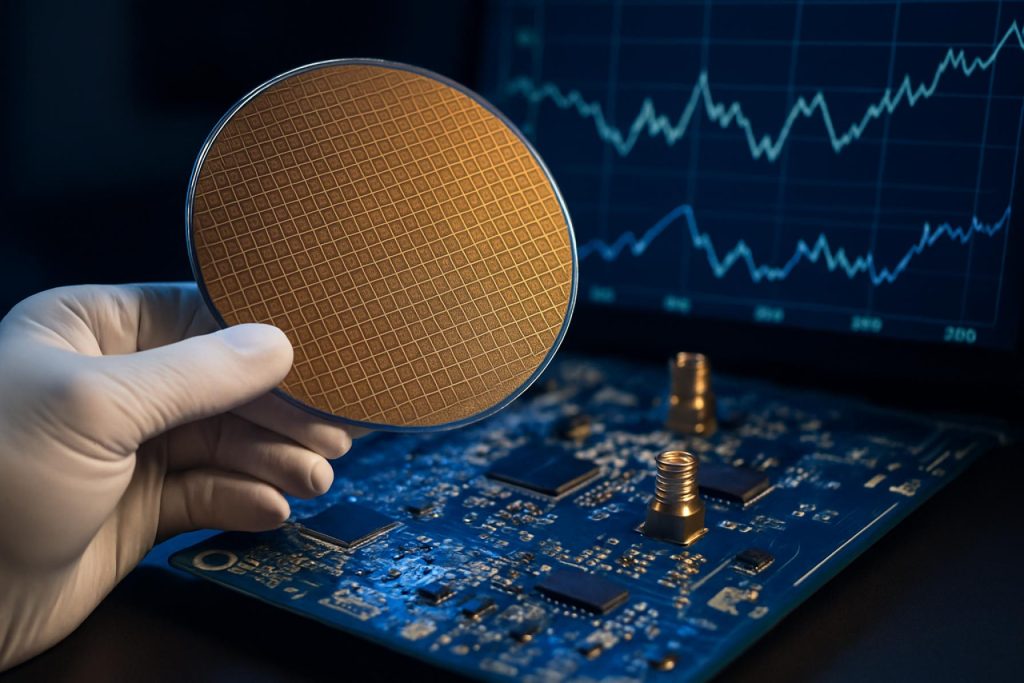
High-Frequency Graphene Electronics Market Report 2025: In-Depth Analysis of Growth Drivers, Technology Innovations, and Global Opportunities
- Executive Summary & Market Overview
- Key Technology Trends in High-Frequency Graphene Electronics
- Competitive Landscape and Leading Players
- Market Growth Forecasts (2025–2030): CAGR, Revenue, and Volume Projections
- Regional Analysis: North America, Europe, Asia-Pacific, and Rest of World
- Challenges, Risks, and Barriers to Adoption
- Opportunities and Future Outlook: Emerging Applications and Investment Hotspots
- Sources & References
Executive Summary & Market Overview
High-frequency graphene electronics represent a rapidly advancing segment within the broader field of next-generation electronic materials. Graphene, a two-dimensional allotrope of carbon, is renowned for its exceptional electron mobility, high thermal conductivity, and mechanical strength, making it a prime candidate for high-frequency (RF and THz) electronic applications. As of 2025, the market for high-frequency graphene electronics is witnessing accelerated growth, driven by increasing demand for faster, more efficient communication systems, advanced sensors, and next-generation computing devices.
The global market for graphene electronics is projected to reach significant milestones, with estimates suggesting a compound annual growth rate (CAGR) exceeding 30% through the end of the decade, particularly in high-frequency applications such as RF transistors, mixers, and detectors. This growth is underpinned by ongoing research and commercialization efforts from leading industry players and research institutions, including Samsung Electronics, IBM Research, and Graphenea. These organizations are pioneering the integration of graphene into high-frequency circuits, targeting applications in 5G/6G wireless infrastructure, satellite communications, and high-speed data converters.
Key market drivers include the limitations of traditional silicon-based electronics at frequencies above 100 GHz, where graphene’s superior carrier mobility enables devices to operate efficiently at terahertz (THz) frequencies. This capability is critical for emerging technologies such as ultra-fast wireless communication, advanced radar systems, and quantum computing interfaces. Furthermore, the miniaturization trend in electronics and the push for energy-efficient components are accelerating the adoption of graphene-based solutions.
Regionally, North America and Europe are leading in terms of research output and early commercialization, supported by substantial investments from both public and private sectors. The Asia-Pacific region, particularly China and South Korea, is rapidly catching up, leveraging robust semiconductor manufacturing ecosystems and government-backed innovation programs (IDTechEx).
Despite the promising outlook, challenges remain, including scalable production of high-quality graphene, integration with existing semiconductor processes, and cost reduction. However, with continued advancements in chemical vapor deposition (CVD) techniques and device engineering, the high-frequency graphene electronics market is poised for robust expansion and technological breakthroughs in 2025 and beyond.
Key Technology Trends in High-Frequency Graphene Electronics
High-frequency graphene electronics are at the forefront of next-generation device innovation, leveraging graphene’s exceptional carrier mobility, high saturation velocity, and atomic thinness to outperform traditional semiconductor materials in radio-frequency (RF) and terahertz (THz) applications. As of 2025, several key technology trends are shaping the evolution and commercialization of high-frequency graphene electronics.
- Advancements in Graphene Field-Effect Transistors (GFETs): The development of GFETs with cut-off frequencies (fT) exceeding 300 GHz is a major milestone, driven by improvements in graphene synthesis and device architecture. Companies and research institutions are focusing on scalable chemical vapor deposition (CVD) techniques to produce high-quality, large-area graphene, which is critical for wafer-scale integration and consistent device performance. Notably, IBM and Samsung Electronics have demonstrated prototype GFETs with record-breaking frequency responses, paving the way for commercial RF circuits.
- Integration with Silicon CMOS Platforms: Hybrid integration of graphene with conventional silicon CMOS technology is gaining momentum, enabling the fabrication of high-frequency analog components such as mixers, amplifiers, and detectors. This approach leverages the maturity of silicon processing while introducing the superior speed and linearity of graphene devices. imec and TSMC are actively exploring monolithic and heterogeneous integration strategies to accelerate market adoption.
- Emergence of Graphene-Based THz Devices: The unique electronic properties of graphene are being harnessed to develop THz sources, modulators, and detectors, addressing the growing demand for high-bandwidth wireless communications and advanced imaging systems. Research from Nature Publishing Group highlights the demonstration of graphene-based THz emitters with tunable frequency ranges, which are expected to play a pivotal role in 6G and beyond.
- Flexible and Transparent RF Electronics: Graphene’s mechanical flexibility and optical transparency are enabling the creation of conformal, wearable, and transparent RF devices. This trend is particularly relevant for the Internet of Things (IoT), smart textiles, and next-generation user interfaces. Companies like Graphenea are supplying high-quality graphene materials tailored for flexible electronics applications.
These technology trends underscore the rapid progress and expanding commercial potential of high-frequency graphene electronics, with industry analysts projecting robust growth as device performance and manufacturing scalability continue to improve (IDTechEx).
Competitive Landscape and Leading Players
The competitive landscape of the high-frequency graphene electronics market in 2025 is characterized by a dynamic mix of established semiconductor giants, specialized graphene technology firms, and research-driven startups. The sector is witnessing rapid innovation, with companies racing to commercialize graphene-based transistors, RF components, and integrated circuits that outperform traditional silicon-based devices in terms of speed, flexibility, and energy efficiency.
Key players include Samsung Electronics, which has made significant investments in graphene transistor research, aiming to leverage its existing semiconductor manufacturing infrastructure for scalable production. IBM continues to be a pioneer, with its research division demonstrating graphene-based RF transistors operating at frequencies exceeding 300 GHz, targeting next-generation wireless and 6G applications.
European firms such as Graphenea and Graphene Flagship consortium members are at the forefront of material supply and device prototyping, benefiting from strong public-private partnerships and EU funding. AMD and Intel are also exploring graphene integration for high-frequency logic and analog applications, though their commercial products remain in the R&D phase as of 2025.
Startups such as NovaCentrix and Directa Plus are focusing on niche applications, including flexible RF devices and wearable electronics, leveraging proprietary graphene synthesis and patterning techniques. Meanwhile, Texas Instruments and Qualcomm are actively patenting graphene-based RF front-end modules, seeking to secure early-mover advantages in the 5G/6G infrastructure market.
- Strategic collaborations between material suppliers and device manufacturers are accelerating the transition from lab-scale prototypes to commercial products.
- Intellectual property (IP) competition is intensifying, with a surge in graphene-related patents filed by both established players and startups.
- Regional clusters, particularly in the US, EU, and East Asia, are fostering innovation through government-backed initiatives and academic-industry partnerships.
Overall, the high-frequency graphene electronics market in 2025 is marked by aggressive R&D, strategic alliances, and a race to achieve scalable, cost-effective manufacturing, with leading players positioning themselves for the anticipated surge in demand from next-generation wireless, defense, and IoT sectors.
Market Growth Forecasts (2025–2030): CAGR, Revenue, and Volume Projections
The high-frequency graphene electronics market is poised for robust expansion between 2025 and 2030, driven by surging demand for next-generation wireless communication, advanced sensors, and high-speed computing components. According to projections from MarketsandMarkets, the global graphene electronics market—which includes high-frequency applications—is expected to register a compound annual growth rate (CAGR) of approximately 38% during this period. This growth is underpinned by the unique electrical properties of graphene, such as exceptional carrier mobility and ultra-fast electron transport, which are critical for high-frequency device performance.
Revenue forecasts indicate that the high-frequency segment will account for a significant share of the overall graphene electronics market. By 2030, the total market revenue for high-frequency graphene electronics is projected to surpass USD 1.2 billion, up from an estimated USD 250 million in 2025, as reported by IDTechEx. This surge is attributed to the accelerated adoption of graphene-based transistors, radio-frequency (RF) components, and terahertz devices in telecommunications infrastructure, 5G/6G networks, and defense applications.
In terms of volume, the number of high-frequency graphene electronic devices shipped is expected to grow exponentially. Global Market Insights estimates that annual unit shipments could reach over 15 million by 2030, compared to fewer than 2 million units in 2025. This volume growth will be fueled by increased integration of graphene components in consumer electronics, automotive radar systems, and industrial IoT devices.
- CAGR (2025–2030): ~38% for high-frequency graphene electronics
- Revenue Projection (2030): >USD 1.2 billion
- Volume Projection (2030): >15 million units shipped annually
Key growth drivers include ongoing R&D investments, favorable regulatory frameworks, and strategic partnerships between material suppliers and electronics manufacturers. However, market expansion may be tempered by challenges such as high production costs and scalability issues. Nevertheless, the outlook for high-frequency graphene electronics remains highly optimistic, with significant opportunities for innovation and commercialization across multiple high-tech sectors.
Regional Analysis: North America, Europe, Asia-Pacific, and Rest of World
The regional landscape for high-frequency graphene electronics in 2025 is shaped by varying levels of research intensity, industrial adoption, and government support across North America, Europe, Asia-Pacific, and the Rest of the World. Each region demonstrates unique strengths and challenges in the commercialization and integration of graphene-based high-frequency devices, such as transistors, sensors, and communication modules.
- North America: The United States leads in high-frequency graphene electronics, driven by robust R&D investments from both public and private sectors. Major universities and research institutions, in collaboration with companies like IBM and Qualcomm, are advancing graphene transistor performance for RF and 5G/6G applications. The region benefits from a mature semiconductor ecosystem and strong venture capital presence, accelerating the transition from lab-scale prototypes to commercial products. However, challenges remain in large-scale, defect-free graphene synthesis and integration with existing silicon-based processes.
- Europe: Europe maintains a competitive edge through coordinated initiatives such as the Graphene Flagship, which unites academic and industrial partners across the continent. Countries like Germany, the UK, and Sweden are at the forefront, focusing on high-frequency graphene electronics for automotive radar, wireless communications, and quantum technologies. European regulatory frameworks and funding mechanisms support pilot manufacturing lines and early market adoption, but the region faces stiff competition from Asia in scaling up production and reducing costs.
- Asia-Pacific: The Asia-Pacific region, particularly China, South Korea, and Japan, is rapidly expanding its footprint in high-frequency graphene electronics. Chinese firms, supported by government-backed programs, are investing heavily in graphene wafer production and device fabrication, aiming to capture a significant share of the global RF device market. South Korea’s electronics giants, such as Samsung Electronics, are exploring graphene for next-generation wireless and sensor applications. The region’s strengths lie in advanced manufacturing capabilities and a large consumer electronics market, though intellectual property and standardization issues persist.
- Rest of World: Other regions, including the Middle East and Latin America, are in the early stages of developing high-frequency graphene electronics ecosystems. Efforts are primarily focused on academic research and small-scale pilot projects, often in collaboration with international partners. Market penetration remains limited due to infrastructure and funding constraints, but long-term opportunities exist as global supply chains diversify.
Overall, the global market for high-frequency graphene electronics in 2025 is characterized by regional specialization, with North America and Europe leading in innovation, and Asia-Pacific excelling in manufacturing scale and commercialization. Strategic partnerships and continued investment will be critical for maintaining competitiveness and addressing technical barriers across all regions.
Challenges, Risks, and Barriers to Adoption
High-frequency graphene electronics, while promising transformative advances in communications, sensing, and computing, face significant challenges, risks, and barriers to widespread adoption as of 2025. The unique properties of graphene—such as high carrier mobility and atomic thickness—enable devices that can theoretically outperform traditional silicon-based electronics at gigahertz and terahertz frequencies. However, several critical obstacles impede commercialization and large-scale deployment.
- Manufacturing Scalability and Consistency: Producing high-quality, large-area graphene with uniform electronic properties remains a major hurdle. Chemical vapor deposition (CVD) is the most common method, but it often results in defects, grain boundaries, and substrate-induced variability, which degrade device performance. The lack of standardized, cost-effective manufacturing processes limits the ability to scale production for commercial applications (IDTechEx).
- Integration with Existing Technologies: Integrating graphene devices with established silicon-based CMOS technology is complex. Graphene’s zero bandgap makes it difficult to achieve the on/off switching behavior required for digital logic, and hybrid integration introduces additional process complexity and reliability concerns (IEEE).
- Device Reliability and Stability: Graphene devices are sensitive to environmental factors such as humidity, temperature, and chemical contamination. Long-term stability and reproducibility of device characteristics are not yet on par with mature semiconductor technologies, raising concerns for mission-critical and commercial applications (Nature Reviews Materials).
- Cost and Economic Viability: The high cost of producing electronic-grade graphene and the need for specialized fabrication equipment increase the overall cost of graphene-based high-frequency devices. This economic barrier is particularly significant when competing with well-established, cost-optimized silicon and compound semiconductor technologies (MarketsandMarkets).
- Regulatory and Standardization Issues: The absence of universally accepted standards for graphene material quality, device testing, and performance benchmarking complicates market entry and slows industry adoption. Regulatory uncertainty also affects investment and partnership decisions (International Organization for Standardization (ISO)).
Addressing these challenges will require coordinated efforts in materials science, process engineering, and industry standardization. Until these barriers are overcome, the adoption of high-frequency graphene electronics will likely remain limited to niche, high-value applications.
Opportunities and Future Outlook: Emerging Applications and Investment Hotspots
The landscape for high-frequency graphene electronics in 2025 is marked by a surge in emerging applications and a dynamic investment climate. Graphene’s exceptional electron mobility and ultra-thin structure position it as a transformative material for next-generation high-frequency devices, particularly in the terahertz (THz) and millimeter-wave (mmWave) domains. These properties are catalyzing opportunities across several sectors, with telecommunications, defense, and advanced sensing leading the way.
One of the most promising applications is in 6G wireless communications, where graphene-based transistors and modulators are being developed to operate at frequencies well above 100 GHz. This enables ultra-fast data transmission and low-latency connectivity, critical for future mobile networks and the Internet of Things (IoT). According to IDTechEx, the integration of graphene in radio-frequency (RF) components is expected to accelerate, with pilot deployments anticipated by 2025–2026.
Another emerging hotspot is in high-frequency photodetectors and modulators for optical communications. Graphene’s broadband absorption and ultrafast carrier dynamics make it ideal for photonic integrated circuits, supporting data centers and quantum communication systems. Companies such as Graphenea and Cambridge Graphene Centre are actively collaborating with telecom giants to commercialize these components.
In defense and security, graphene-based high-frequency electronics are being explored for advanced radar, electronic warfare, and THz imaging systems. The U.S. Department of Defense and the European Defence Agency have both increased funding for graphene-enabled sensor and communication platforms, recognizing their potential for enhanced sensitivity and miniaturization (U.S. Department of Defense).
From an investment perspective, venture capital and corporate R&D spending are flowing into startups and research consortia focused on scalable graphene device fabrication and integration. Asia-Pacific, particularly China and South Korea, is emerging as a key investment hotspot, driven by government-backed initiatives and partnerships with leading semiconductor manufacturers (StatNano).
- 6G and beyond wireless infrastructure
- High-speed optical interconnects
- THz imaging and spectroscopy
- Quantum and neuromorphic computing hardware
Looking ahead, the convergence of material innovation, device engineering, and strategic investment is expected to unlock new markets for high-frequency graphene electronics, with commercial breakthroughs likely within the next three to five years.
Sources & References
- IBM Research
- IDTechEx
- imec
- Nature Publishing Group
- Directa Plus
- Qualcomm
- MarketsandMarkets
- Global Market Insights
- Graphene Flagship
- IEEE
- International Organization for Standardization (ISO)
- StatNano



